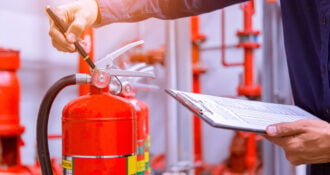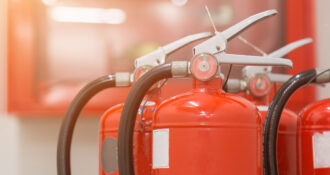Fire safety is a paramount concern for any responsible individual or organisation. One of the fundamental tools in fire safety is the fire extinguisher, a device designed to control or extinguish small fires before they escalate. This comprehensive guide will delve into the various aspects of fire extinguishers, providing answers to frequently asked questions and essential information. As a trusted name in fire safety, Firechief is committed to educating people on how to respond effectively in a fire emergency.
Understanding Fire Extinguishers
Understanding Fire Extinguishers is the cornerstone of effective fire safety. Delving deeper into these crucial devices involves grasping the intricate interplay of heat, fuel, and oxygen – the fundamental elements forming the fire triangle. Fire extinguishers, including versatile options like foam fire extinguishers and carbon dioxide fire extinguishers, operate by disrupting this combustion process. Recognising the nuances of different fire extinguisher types, such as wet chemical fire extinguishers designed for class F fires involving cooking oils, empowers individuals to respond accurately to specific fire hazards. This knowledge ensures the proper selection of extinguishing agents and underscores the importance of timely action during a fire emergency, aligning with our commitment to comprehensive fire safety education.
Importance of Fire Extinguisher Knowledge
Understanding fire extinguishers is not just a matter of having the equipment; it’s about possessing the knowledge to employ it correctly. This knowledge is an invaluable asset in saving lives and protecting property. In the critical moments of a fire emergency, a prompt and accurate response becomes the linchpin of effective intervention. The ability to deploy a fire extinguisher accurately can be the determining factor in preventing a minor incident from escalating into a catastrophic blaze.
Familiarity with different fire classes is essential for comprehensive fire safety. Knowing the nuanced applications of extinguishers, such as the specialised use of a wet chemical fire extinguisher in combating class F fires involving cooking oils, ensures that individuals are not merely equipped with tools but also possess the expertise to mitigate specific fire hazards effectively. The investment in understanding the diverse scenarios involving electrical fires, flammable liquids, and flammable gases pays dividends in promoting a safer environment for all.
Fire Safety Precautions
Fire safety encompasses a holistic approach beyond fire extinguishers’ presence. While these devices are integral, a comprehensive fire safety strategy involves a synergy of preventive measures. Beyond the crucial fire equipment, incorporating essential elements such as smoke alarms, evacuation plans, and proper storage of flammable materials is imperative. Smoke alarms act as vigilant sentinels, providing early detection and triggering timely responses. Evacuation plans ensure an organised and efficient exit strategy in the event of a fire emergency, particularly vital in scenarios involving class E fires and electrical equipment. Proper storage of flammable materials mitigates the risk of fires involving flammable liquids and contributes to a safer environment.
A thorough assessment of premises is a cornerstone of effective fire safety. Firechief underscores the importance of identifying potential fire hazards and proactively implementing preventive measures. This entails scrutinising the surroundings for potential risks related to class B fires and various fire extinguisher types. Conducting regular assessments ensures that fire safety measures evolve with the changing dynamics of a space, providing robust protection against unforeseen emergencies. In adopting a proactive stance toward fire safety, individuals and organisations can fortify their defences and contribute to a safer, more secure environment.
Types of Fire Extinguishers
Fire extinguishers come in various types, each designed to combat specific classes of fires. Understanding these types is crucial for effective fire management. Firechief offers a range of high-quality fire extinguishers designed for different environments and fire risks.
- Water-Fire Extinguishers: Suitable for Class A fires involving ordinary combustibles like wood and paper.
- Foam Fire Extinguishers: Effective on Class A and B fires, these extinguishers create a barrier to suppress flammable vapours.
- Dry Powder Fire Extinguishers: Versatile and suitable for Class A, B, and E fires, these are effective on combustible solids, liquids, and gases.
- CO2 Fire Extinguishers: Ideal for electrical fires (Class E) without leaving a residue.
- Wet Chemical Extinguishers: Suitable on Class F fires involving cooking oil.
Understanding the specific use cases for each type of fire extinguisher is crucial for effective fire response.
When and How to Use Fire Extinguishers
Knowing when and how to use a fire extinguisher is as important as having one. Firechief recommends following these general steps:
- Evaluate the Situation: Ensure that the fire is small and contained. If the fire is spreading rapidly or is too large to handle, evacuate immediately and call emergency services.
- Select the Right Extinguisher: Choose the appropriate type of fire extinguisher for the fire class. Using the wrong type can be ineffective or even dangerous.
- Remember PASS:
- Pull: the pin to unlock the extinguisher.
- Aim: the nozzle or hose at the very base of the fire.
- Squeeze: the handle which will release the extinguishing agent.
- Sweep: from side to side, covering the fire with the extinguishing agent.
- Maintain a Safe Distance: Stand at a safe distance from the fire, moving closer as the fire diminishes.
- Observe the Fire: Even if the fire appears to be out, keep a close eye on it in case it reignites.
Maintenance and Inspection of Fire Extinguishers
Proper maintenance and regular inspection are essential to ensure that fire extinguishers are ready for use when needed. Firechief recommends the following maintenance practices:
- Regular Inspections: Conduct monthly visual inspections to check for obvious issues such as damage or missing parts.
- Six Monthly Servicing: Schedule professional servicing six monthly to ensure the extinguisher is in optimal condition.
- Hydrostatic Testing: All types of extinguishers require hydrostatic testing every five years to check their pressure vessels for leaks.
- Recharging: If an extinguisher is used, even partially, it needs to be recharged immediately.
Frequently Asked Questions
Q1. What is the Australian standard for fire extinguishers?
A1. In Australia, fire extinguishers must comply with the AS 1851 & AS 2444 standards. These standards outline the requirements for selecting, installing, and maintaining portable fire extinguishers.
Q2. What are the four main types of fire extinguishers used for?
A2. The five main types of fire extinguishers are used for different classes of fires:
- Water Fire Extinguishers: Class A fires (ordinary combustibles).
- Foam Fire Extinguishers: Class A and B fires (flammable liquids).
- Dry Powder Fire Extinguishers: Class A, B, and E fires
- CO2 Fire Extinguishers: Class E fires (electrical equipment)
- Wet Chemical Fire Extinguishers: Class F fires ( cooking oils)
Q3. What are the Colours of fire extinguishers in Australia?
A3. Fire extinguishers in Australia are colour-coded for easy identification:
- Water: Red
- Foam: Blue
- Dry Powder: White
- CO2: Black
- Wet Chemical: Oatmeal
In conclusion, understanding the nuances of fire extinguishers is crucial for effective fire safety. Firechief, as a leader in the field, emphasises the importance of having the right equipment and being informed and prepared. By following the guidelines provided, individuals and organisations can provide a safer environment for everyone.
Equip yourself with the knowledge and tools needed to protect against the unexpected. Explore Firechief’s range of high-quality fire extinguishers and ensure you are prepared for any fire emergency. Remember, being informed and proactive can make all the difference in the face of a fire.



